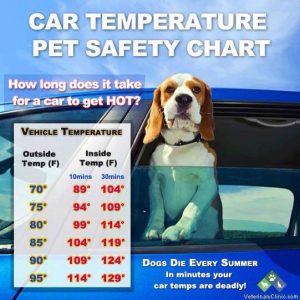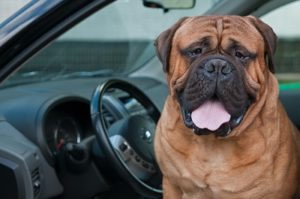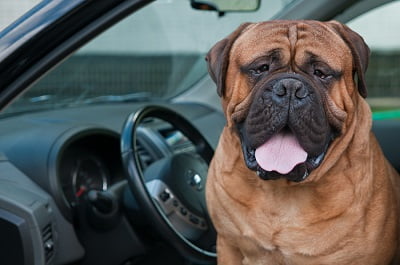
Summer is upon us and so is the heat. I’m sure we’ve all seen a dog panting heavily in a car with the windows cracked or a few inches down in the parking lot of the grocery store. We hope that the owner returns soon and wonder, “Does leaving the windows cracked an inch or two make a difference?”
Unfortunately, No, it does not. Studies have shown that leaving the windows open or cracked a few inches, is very close to leaving the windows completely shut, as there is very little air circulation inside the car.
Many folks do not realize how quickly a car can heat up, even in moderate weather. The chart at the right shows that even on a moderate 70 degree day, your car can become a scorching 104 degrees in a very short period of time.
What do you do if you see a dog in a hot car?
Step #1
Get the vehicle’s tag number and enter the nearest store or business to request an emergency announcement be made about a pet left in a hot car. If no one responds in a short time, call the Animal Control or your local law enforcement.
Step #2
Go back to the car and wait for police at the vehicle.
If the authorities are going to be delayed for a significant length of time and it is evident the dog is in dire distress, you can break the window and remove the animal. Note: This statement applies to California. If you live in a different state, please check with your local and/or state government officials to determine the proper and legal procedure to follow.
California Penal Code 597.7 reads as follows:
“Peace officer, firefighter, humane officer, animal control officer, or other emergency responder:
A peace officer, firefighter, humane officer, animal control officer, or other emergency responder is authorized to take all steps that are reasonably necessary for the removal of an animal from a motor vehicle.
Must leave written notice bearing his or her name and office, and the address of the location where the animal can be claimed.
Any person:
In 2016, changes were made to the law that allow any person to take reasonable steps necessary to remove an animal from a motor vehicle if the person holds a reasonable belief that the animal’s safety is in immediate danger from heat, cold, lack of adequate ventilation, lack of food or water, or other circumstances that could reasonably be expected to cause suffering, disability, or death to the animal.
This person will not be criminally liable for actions taken reasonably and in good faith if the person does all of the following:
- Determines the vehicle is locked or there is otherwise no reasonable manner for the animal to be removed from the vehicle
- Has a good faith belief that forcible entry into the vehicle is necessary because the animal is in imminent danger of suffering harm
- Contacted a local law enforcement agency, the fire department, animal control, or 911 prior to forcible entry
- Remains with the animal in a safe location, but close by until emergency responders arrive
- Used no more force than necessary to enter the vehicle and remove the animal
- Immediately turns the animal over to a representative from law enforcement, animal control, or another emergency responder
Note: (Bold Mine)
Recognizing Signs of Heat Stroke

Once the animal is out of the vehicle, look for signs of heat stroke which can include:
- Panting heavily
- Lethargic
- Glazed eyes
- Rapid pulse
- Unsteady
- Staggering gait
- Vomiting
- Deep red or purple tongue
- Pale or Grey gums
- If any or some of these signs are present, the dog is probably experiencing heat stroke.
If at all possible –
- Run cool water under their arms and groin area
- Place wet towels over the back of his neck, ear flaps and bottoms of his paws.
Emergency Steps to Treat Heat Stroke
If your dog seems to be experiencing heat stroke, immediately do the following:
- Stop in a shaded area and move them to an air-conditioned area
- Offer them fresh water, but don’t force them to drink. Move them inside to an air-conditioned area.
- Run cool water under their arms and undercarriage.
- Direct a fan on the wet areas to speed evaporative cooling.
- Contact your emergency veterinarian.
Preventing Heat Stroke in Your Dog
Here are some things you can do:
- Provide plenty of fresh, cool water.
- Keep him home if it is a warm day.
- Provide him a cool place where he can lie down.
- Offer Ice cubes that are made of chicken or beef broth to encourage your dog to increase his fluid intake.
- Feed Wet Dog Food to increase fluid intake.
- Provide a child’s wading pool filled with cool water for him to stand in. Dogs cool off from panting and cool down through the sweat glands in their paws. This will help lower his body temperature. You can also run cool water on his chest and under his arms and hind legs.
- If you keep him in an air-conditioned room, be aware that he will have a harder time to adjusting to the heat outside, when you bring him outdoors.
- Take him for walks in the early morning or later in the evening. Do not walk him in mid-day heat.
- Walk on dirt or grass. Avoid asphalt or sidewalks. As a test, put your hand on the sidewalk for asphalt for 45 seconds. If it is hot to your hand, it will be hot to the pads on his feet.
- Remember, your dog is lower to the ground and will absorb the heat much more readily then you do, as more of his body area is exposed to the heated surface … and he is wearing a fur coat!
- Dark colored dogs will absorb the heat quicker than lighter colored dogs.
- Light colored dogs are more prone to sunburn.
- If you clip your dog, be sure to have the groomer leave at least 1” of fur as it serves as protection against sunburn. It also serves as insulation from the heat.
- Dog Houses do not provide circulation or protection from the heat.
- Fans and mats that have cooling crystals can stay up to 20 degrees cooler then the room temperature.
- Wet towels on a concrete or tile floor in front of a fan or air conditioner can also reduce your dog’s body temperature in extreme heat.
Heat Exhaustion Factors
- Obesity
- Short muzzled dogs such as Pekingese, Boxers, Boston Terriers, Pugs, and Bulldogs are prone to heat stroke
- Young dogs (puppies) and Older Dogs
- Dogs with heart conditions or other ailments are prone to heat stroke
- Long haired breeds or dogs with thick, double coats (Alaskan Malamutes, Siberians, Collies, Australian Shepherds) are more susceptible to heat stroke
It is my hope that the information included in this article will be of help to you and your dog so you can both stay cool and enjoy the Dog Days of Summer!
THE INFORMATION, CONTENT AND MATERIAL CONTAINED IN THIS ARTICLE IS INTENDED TO BE OF A GENERAL NATURE ONLY AND IS NOT INTENDED TO CONSTITUTE PROFESSIONAL ADVICE. ALWAYS SEEK THE ADVICE OF A PROFESSIONAL DOG TRAINER, VETERINARIAN OR OTHER QUALIFIED PROFESSIONAL IN CONNECTION WITH THE CARE, TRAINING AND HANDLING OF DOGS. RELIANCE ON ANY INFORMATION THAT APPEARS IN THIS ARTICLE, WHETHER PROVIDED BY THE AUTHOR, ELAINE SGROI, OR OTHERS IS SOLELY AT YOUR OWN RISK.
